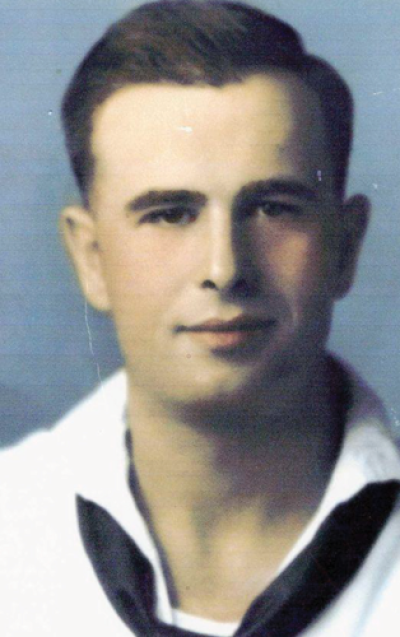
While serving in the U.S. Navy, John Cuthbert Auld, of Detroit, was killed during the attack on Pearl Harbor on Dec. 7, 1941. At press time, he was expected to be laid to rest on Dec. 6 with full military honors at Fairview Memorial Park in Albuquerque, New Mexico.
Photo provided by the Public Affairs Office, Navy Personnel Command

Sailors aboard the USS Oklahoma pose for a group photo.
Photo provided by the Public Affairs Office, Navy Personnel Command
DETROIT — While growing up, Richard Auld remembers his grandmother, Lillian, and his dad, Edwin, sharing memories about a family member named Jack.
But he wasn’t sure who Jack was, until one day he realized the stories were about his uncle, John Cuthbert Auld, who was nicknamed Jack. The U.S. Navy man, who grew up in Detroit, was killed during the bombing of Pearl Harbor on Dec. 7, 1941.
This year marks the 83rd anniversary of the Pearl Harbor attack, which killed approximately 2,400 American service members and civilians.
In time, Auld learned more about his uncle, a 23-year-old seaman 2nd class who was aboard the USS Oklahoma when naval and air forces of the Japanese empire attacked the American base on Hawaii’s island of Oahu. On the following day, Dec. 8, President Franklin Delano Roosevelt addressed Congress and asked for a declaration of war with Japan, which drove the United States into World War II.
“They rescued several sailors that day after the attack,” Auld said. “Everyone else was presumed dead. They didn’t have much hope. They always told me he died on the Oklahoma.”
While the family knew John didn’t survive, his remains were only officially identified after Auld provided a DNA sample in 2017. At press time, John was set to be laid to rest at 10 a.m. Dec. 6 with full military honors at Fairview Memorial Park in Albuquerque, New Mexico. Auld, who resides in Albuquerque, said the cemetery was chosen because that is where Lillian and Edwin are buried.
“It will be an honor to have him with his mom and his brother,” Auld said.
Family members and friends were expected to attend the burial. John also was expected to receive military honors at the airport when his remains arrived.
For his service, John was awarded the following medals and decorations: Purple Heart medal, Combat Action Ribbon, Good Conduct Medal, American Defense Service Medal with fleet clasp, Asiatic-Pacific Campaign Medal with bronze star, World War II Victory Medal, and American Campaign Medal.
‘It’s definitely a huge loss.’
John was born in Newcastle upon Tyne, England, on June 15, 1918. The family moved to the U.S. and settled in Detroit. On Nov. 6, 1940, John enlisted in the Navy and underwent basic training at Naval Station Great Lakes, in Illinois.
John’s seaman duties included painting, cleaning and polishing the vessel’s brightwork, equipment repair, storing and securing items, and assisting with cargo. The young man also stood watches as a lookout, telephone talker and messenger, and he was a member of a gun crew.
Richard Auld’s dad, Edwin, four years younger than John, served in the U.S. Air Force from 1942-46.
“They were normal kids in a good family. It’s definitely a huge loss. I never got to meet him,” said Auld, who was born in 1960. “Every Dec. 7, we talked about him. I feel like I know him now after the Navy’s recovery efforts.”
Auld’s dad moved the family, including wife, Esther, to New Mexico to work in the grocery business. Auld has some photos of his uncle and has been told there is a family resemblance.
A few years ago, Auld and his wife Karen traveled to Honolulu, Hawaii for a ceremony at the National Memorial Cemetery of the Pacific to pay tribute to the 33 unaccounted for sailors from the USS Oklahoma buried with full military honors.
“Very emotional,” Auld said. “It was very moving.”
According to the Navy, since the ceremony, one more sailor, radioman 3rd class Frank Hoag Jr., has been identified.
Project Oklahoma
On Dec. 2, the Navy Personnel Command Public Affairs Office issued a press release that included information about Project Oklahoma, a disinterment and identification project through the Defense POW/MIA Accounting Agency.
During Project Oklahoma, the Navy’s POW/MIA Office contacted family members to ask for their participation in the Family Reference Sample Program. That is where surviving family members of a veteran killed on duty offer DNA samples that are used to determine if there is a match.
That is exactly what Auld did to confirm his uncle’s remains.
Through the process, 356 of the 388 service members from the USS Oklahoma who were originally unaccounted for have now been identified, according to Capt. Jeff Draude, director, Navy Casualty Office.
Scientists with the DPAA, in Joint Base Pearl Harbor-Hickam, Hawaii and Offutt Air Force Base in Omaha, Nebraska, are responsible for identifying unaccounted for service members by matching the DNA reference samples from surviving family members. Other documents, including available medical and dental records, are also used.
The Navy Casualty Office’s policy for notification is to work directly with the primary next of kin with matters involving their loved one’s remains. Once the DPAA makes a positive identification, the Navy’s Casualty Office conducts an official notification to the next of kin.
Once the identification brief has concluded, the family can decide to have the remains interred in a local national or state cemetery, a private cemetery, reinterred in the National Memorial Cemetery of the Pacific in Hawaii, or Arlington National Cemetery. Families may also choose to have the remains cremated and retained with the family.
“When briefing families, we often hear things like, ‘My family did not believe he was dead,’ or, ‘He probably was not on board the ship,’ or, ‘Maybe one day he would walk through the door,’” Draude said. “Being able to recover and identify the remains of these sailors aids in the closure to these families.
“It is especially important to the Navy to honor our sailors and Marines who paid the ultimate sacrifice in giving their lives for our country,” Draude said. “Often the notification and identification briefing can be emotional, overwhelming and relieving for the families. Most families we speak with cannot believe their loved one has actually been recovered and/or identified after so many years.”
The Navy covers all primary mortuary expenses: preparation of the remains, casket of choice, all transportation of remains from the lab to final resting place, and family travel and lodging for up to three family members.
 Publication select ▼
Publication select ▼

















